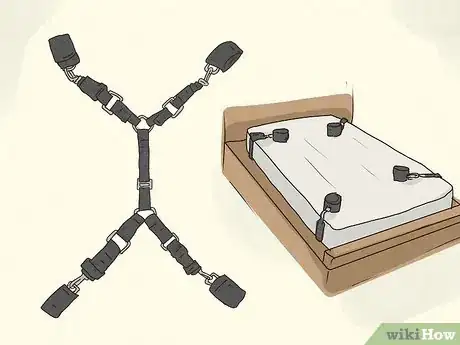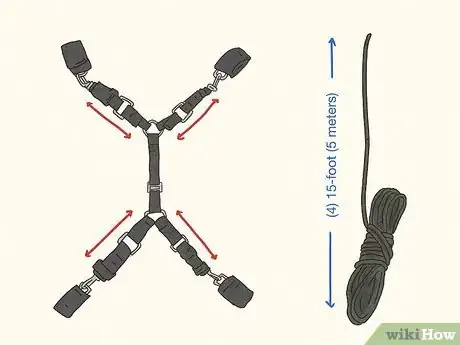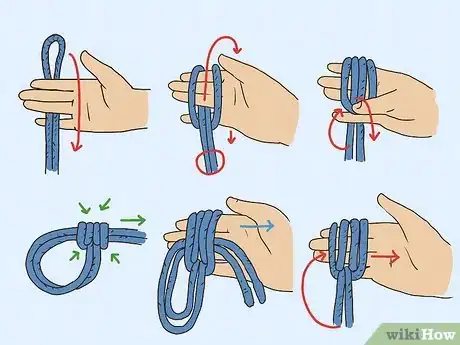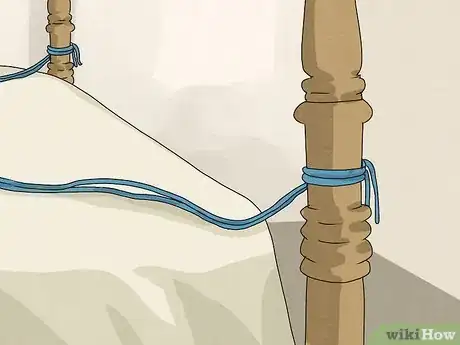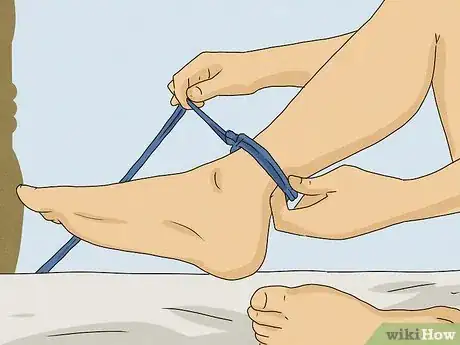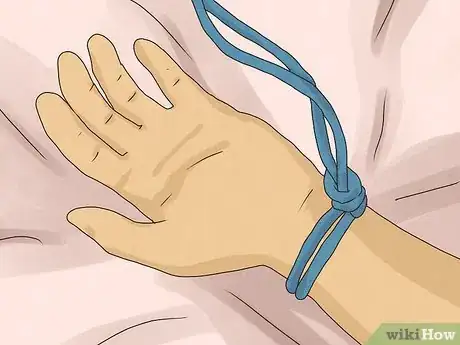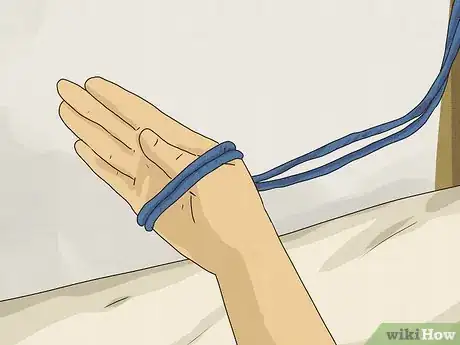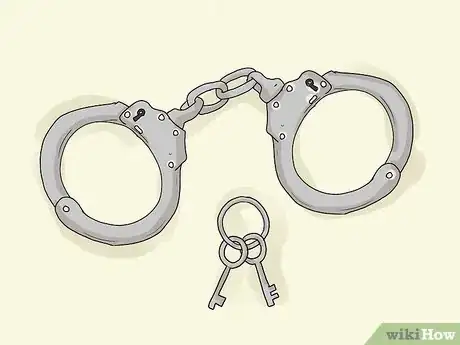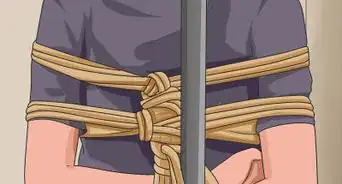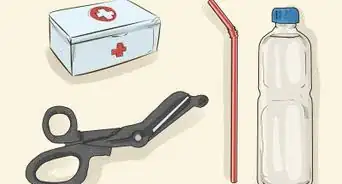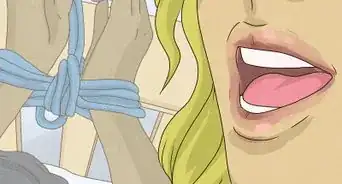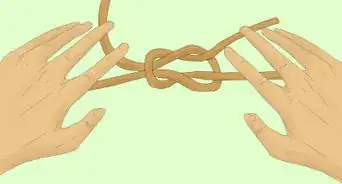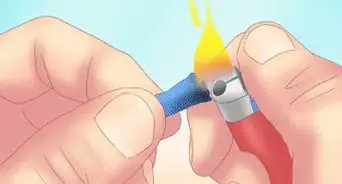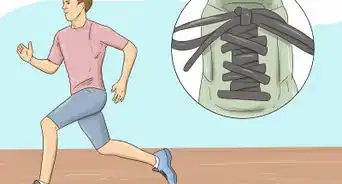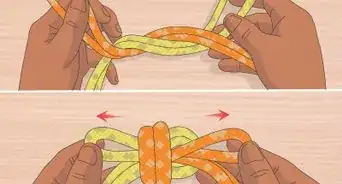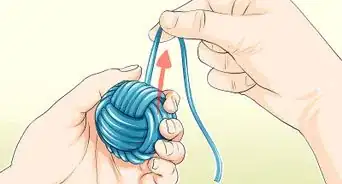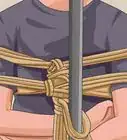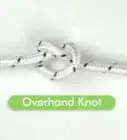This article was co-authored by wikiHow staff writer, Jennifer Mueller, JD. Jennifer Mueller is a wikiHow Content Creator. She specializes in reviewing, fact-checking, and evaluating wikiHow's content to ensure thoroughness and accuracy. Jennifer holds a JD from Indiana University Maurer School of Law in 2006.
There are 16 references cited in this article, which can be found at the bottom of the page.
This article has been viewed 413,577 times.
Learn more...
Because a spread eagle tie involves restraining all 4 limbs, it's a pretty difficult tie to do yourself. That doesn't mean it's impossible! What it does mean, though, is that you need to take extra care and be extremely cautious of your own safety. In the event of an emergency, you need to be able to get free—this typically means having another person with you or on standby who you can contact immediately.
Things You Should Know
- Invest in an under-the-bed system for the easiest restraint solution.
- Wrap and secure the ropes around each of the 4 bed posts.
- Secure your ankles using the 2 lower ropes first.
- Put your non-dominant hand in the wrist coil or cuff and tighten it. Then, slide your dominant hand into the final wrist coil or cuff.
Steps
Setting the Scene
-
1Buy an under-the-bed system for an easier restraint solution. Search online or wherever adult accessories are sold for an under-the-bed restraint system. There are many available at a wide range of prices. The system will still take a little work to set up, but it's not as difficult or complicated as tying rope yourself.[1]
- Typically, you'll have to remove the mattress completely to put the system in place. There's usually a center anchor and 4 straps that lead to each corner. Pull these taut and replace the mattress on top.
-
2Measure the correct amount of rope for each point if you're tying yourself. You need enough rope to wrap around each post at least once and get to your wrists and ankles. If you're not using cuffs, you also need enough rope to knot and wrap around your wrists and ankles. Having 4 15-foot (about 5-meter) ropes (one for each corner) will usually be sufficient.[2]
- When using rope, keep in mind that it's always better to have too much than to not have enough. While you can attach two ropes together to extend them, that just complicates things. It's much easier just to have rope the length you need to start with.
- If you're using an under-the-bed system, you don't have to do this—the straps are adjustable.[3]
Advertisement -
3Create a zip snare knot in each of the ropes. Put the 2 ends of a rope together, then follow them down until you find the middle (the "bight"). Run the 2 tails between your pinkie and ring finger, then fold the bight down over your hand (palm facing you). Pull the tails all the way through the bight, then wrap them over the top and back of your hand and pull them through the bight again. Now, take the ends of the rope and run them horizontally through the column of rope around the 4 fingers of your hand. Pull them through, leaving enough to create a loop. Then, slip your fingers out of the column and tighten it around the rope.[4]
- Zip snare knots work great because they don't slip or collapse once they're in place, so you can struggle or pull against them all you want and not have to worry about pinching a nerve or cutting off your circulation.[5]
-
4Secure the ropes around each of the 4 points. If you're using rope to tie yourself, wrap it around each of the 4 bedposts and secure it using any knot you like. Even a simple overhand knot can do the trick![6]
- Don't have secure bedposts? Use a simple overhand knot to tie 2 ropes together and run them under the top of the mattress so that the ends are sticking out. Do the same thing on the bottom.[7]
Securing the Rope
-
1Connect your ankles to the lower points. Since you're self-tying, do your ankles first. It's likely going to be easier to start with your non-dominant side. Once that ankle is secure, move over and secure the other ankle.[8]
- This does require a bit of flexibility, but if you can touch your toes with your legs spread out, you shouldn't have any problems.
-
2Put your non-dominant hand in the wrist coil or cuff. Lie down on the bed and slide your non-dominant hand into the rope coil or wrap the cuff around your wrist. Use your dominant hand to tighten it.[9]
- If you're using rope, be careful not to cinch it too tight! Remember, you should be able to easily slip 2 fingers between the rope and your skin.[10]
-
3Slide your dominant hand into the final wrist coil or cuff. At last, it's time to set the final piece of your scene in place. When you're ready, work your hand into that last coil or cuff and tighten it up as best you can. Now you have nothing to do but wait for your scene to start—perhaps by your partner coming into the room and "finding you" in this position.[11]
- If the person who's going to find you isn't within shouting distance, make sure they're only a minute or two from opening the door before you restrain your last arm. If you end up restrained and have to wait too long, it could ruin your mood (and your scene).
-
4Attach one wrist coil or cuff with a padlock for a different escape method. This one requires a little more manual dexterity (and some practice to make sure you can do it under pressure). Use some rope or cord to attach your wrist coil or cuff to the rope or cord that's attached to the point. Then, connect the ends of the rope or cord with a padlock that has a key. Keep the key where you can reach it so you can twist your fingers around and open the padlock if necessary.[12]
- Make sure the key is in a spot where it's not going to get lost! This is especially important if struggle is part of your scene. You don't want to accidentally knock the key on the floor or have it fall under something and get lost.
Community Q&A
-
QuestionWhat should you wear when tying yourself up in this position?
 wikiHow Staff EditorThis answer was written by one of our trained team of researchers who validated it for accuracy and comprehensiveness.
wikiHow Staff EditorThis answer was written by one of our trained team of researchers who validated it for accuracy and comprehensiveness.
Staff Answer wikiHow Staff EditorStaff AnswerYou can wear whatever you want (or nothing at all). The degree to which you are dressed or undressed is completely up to you and depends on what you have planned to happen while you're tied up.
wikiHow Staff EditorStaff AnswerYou can wear whatever you want (or nothing at all). The degree to which you are dressed or undressed is completely up to you and depends on what you have planned to happen while you're tied up. -
QuestionCan I tickle someone when they're tied up like this if they're under 18?
 wikiHow Staff EditorThis answer was written by one of our trained team of researchers who validated it for accuracy and comprehensiveness.
wikiHow Staff EditorThis answer was written by one of our trained team of researchers who validated it for accuracy and comprehensiveness.
Staff Answer wikiHow Staff EditorStaff AnswerNo, you should never tie up someone who's under the age of 18 because they can't consent to this type of play. If you come across someone under the age of 18 who has tied themselves up like this, untie them immediately. Tickling them or taking advantage of them in any way while they're tied up would be considered assault.
wikiHow Staff EditorStaff AnswerNo, you should never tie up someone who's under the age of 18 because they can't consent to this type of play. If you come across someone under the age of 18 who has tied themselves up like this, untie them immediately. Tickling them or taking advantage of them in any way while they're tied up would be considered assault. -
QuestionHow can I get a friend to do this to me if they don’t want to?
 wikiHow Staff EditorThis answer was written by one of our trained team of researchers who validated it for accuracy and comprehensiveness.
wikiHow Staff EditorThis answer was written by one of our trained team of researchers who validated it for accuracy and comprehensiveness.
Staff Answer wikiHow Staff EditorStaff AnswerIf they don't want to, find someone else who does. You should never coerce or attempt to persuade someone to do something like this if they don't want to. Respect their boundaries.
wikiHow Staff EditorStaff AnswerIf they don't want to, find someone else who does. You should never coerce or attempt to persuade someone to do something like this if they don't want to. Respect their boundaries.
Warnings
- Even though you're completing the tie yourself, it's best to have a supervisor. That way, they can help you if something goes wrong or cut you loose if there's an emergency.⧼thumbs_response⧽
- Bondage is not a "safe" activity. Make sure you understand the risks before restraining yourself. Put safety concerns above everything else to minimize the risk as much as possible.[16]⧼thumbs_response⧽
- Forego a blindfold if you're going to be tying yourself up spread eagle. In the event of an emergency, you'll have no way to release yourself if you can't see (and no way to remove the blindfold if your hands are restrained).[17]⧼thumbs_response⧽
- Never tie yourself up to "surprise" someone—this is a consent violation. Have a conversation beforehand to make sure they're comfortable with this type of play.[18]⧼thumbs_response⧽
References
- ↑ https://badgirlsbible.com/bondage-positions
- ↑ https://youtu.be/e307K7tPNUE?t=47
- ↑ https://youtu.be/gRCiZWBNlPQ?t=40
- ↑ https://youtu.be/w7j-VplpCb8?t=34
- ↑ https://youtu.be/e307K7tPNUE?t=149
- ↑ https://www.outdoorlife.com/photos/gallery/hunting/2012/02/essential-knots-how-tie-20-knots-will-keep-you-alive/
- ↑ https://youtu.be/e307K7tPNUE?t=223
- ↑ https://youtu.be/gRCiZWBNlPQ?t=10
- ↑ https://youtu.be/gRCiZWBNlPQ?t=73
- ↑ https://www.theduchy.com/courses/safety/#general-rope-safety
- ↑ https://youtu.be/gRCiZWBNlPQ?t=97
- ↑ https://youtu.be/gRCiZWBNlPQ?t=95
- ↑ https://www.selfbound.net/tech/safety.html
- ↑ https://spca.bc.ca/news/cats-collars-breakaway-design-important/
- ↑ https://www.theduchy.com/courses/safety/#general-rope-safety
- ↑ https://ropestudy.com/courses/101/lessons/reducing-risk/topic/risk-vs-safety/
- ↑ https://www.selfbound.net/tech/safety.html
- ↑ https://med-fom-brotto.sites.olt.ubc.ca/files/2019/04/Dunkley-Brotto-Sexual-Abuse.pdf
